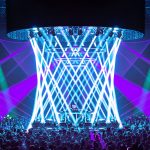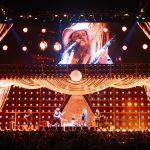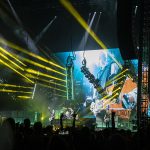A TV Lighting Crew Takes On the World’s Toughest Obstacle Course
Japanese TV has long featured contests where everyday people risk public humiliation for a chance at getting on national TV — picture 10 contestants in inflatable bowling pin costumes waddling away from a giant rolling ball. But Sasuke, or Ninja Warrior, a series of TV specials that first hit the airwaves in 1997, is different. These competitions focus more closely on each participant’s Ninja-like qualities: strength and agility.
The Backstory
In 2007, Sasuke-style courses crossed the Pacific and emerged as the American Ninja Challenge. The concept gained traction, and the competition was renamed American Ninja Warrior, matching the name of the series of shows that the G4 network started broadcasting in 2009.
Last year, NBC joined G4’s coverage with a two-hour special covering the Sasuke finals in Japan in 2011. There, American Ninja Warrior finalists faced off against their Japanese counterparts.
This year, G4 and NBC teamed up for an expanded series of American Ninja Warrior broadcasts. It started earlier this year with six regional contests at three locations: Venice Beach in Los Angeles, Fair Park in Dallas and Florida International University in Miami. Those shows led up to the finals, which were recorded in Las Vegas and seen on July 29.
The regional competitions started with segments taped in broad daylight. After the field was narrowed, the top athletes returning for even tougher challenges at night. The Vegas finale, by contrast, was taped only at night, with the bright lights from the adjacent casinos on the Strip available as a wide-shot backdrop.
The Crew
Adam Biggs, lighting designer and director of photography for American Ninja Warrior, worked with programmer, lighting director and longtime friend Edward Motts on the full series of shows.
“I look at it as kind of like a video game for adults, where they get to go play,” Biggs says. “It had to look cool,” he adds. “That was the whole point.”
Color played a key role. “We came up with this whole color scheme for if they failed, “ Biggs says. “The entire course would turn red,” he adds, a massive look achieved with hundreds of LED truss warmers.
A Big Area
Although the courses in Miami, Dallas and Los Angeles were similar, the modular setup varied. The design for Miami, for example, included palm trees.
One tricky aspect that didn’t change, location to location, was the need to evenly light the courses at night — without, of course, blinding the competitors.
In Miami, Dallas and Los Angeles, that meant illuminating an area about the size of a football field. For the Las Vegas finale, it was the same challenge, “only on steroids,” Biggs says. The Vegas course was three times the size of the regional obstacle courses. “We had to light the architecture and the environment all around us.”
Prepping the Set
 The Vegas finale took place in a dirt lot between the Luxor Hotel and Casino and McCarran Airport. A month before taping, crews dug the pools deep enough for falling contestants. The truss and scaffolding went up in three days, and the lighting load-in took place 14 days prior to taping.
The Vegas finale took place in a dirt lot between the Luxor Hotel and Casino and McCarran Airport. A month before taping, crews dug the pools deep enough for falling contestants. The truss and scaffolding went up in three days, and the lighting load-in took place 14 days prior to taping.
As they raced to run all the cable and hanging all the fixtures, “we were throwing dirt on top of the cables to help hide them from wide shots and prevent tripping hazards,” Motts says.
Although the competitors were challenged by only one obstacle course at a time, the lighting crew needed to have every course fully lit for wide shots and aerial views — and it all needed to look impressive while competing for visual attention with the Las Vegas strip.
Mountain of Light
The towering structure dubbed Mount Midoriyama (a tie-in with the original Sasuke competitions in Japan) served as a focal point for the sprawling set.
“We had to come up with something that would make it look good at night within what they had budgeted for us,” notes Biggs. “We wanted to put some sort of graphic element in the tower to make it feel ‘blockbuster big.’ We came up with this idea of bring in all these Martin LED panels and VersaTubes in a certain configuration and treating Mount Midoriyama as a giant mountain of light.”
Test of Endurance
Before the competitors arrived, the lighting crew faced an ordeal of their own. “The conditions were hectic,” Motts says. “The heat — it was 100 degrees plus, and a nightmare during the day.” Trying to avoid the worst of the heat, Biggs, Motts and crew began coming in later in the day, preparing for nighttime shots. But “we couldn’t wait for the nighttime,” he adds.
If Las Vegas is one of the driest cities in the U.S., it also gets its share of freak wind and rainstorms, adding another challenge to the mix. “We would have to re-focus the boom lights each night as they would have to come down each night due to wind conditions,” Motts says.
And despite that sandy outward appearance, the true consistency of the Mojave Desert soil was closer to “bedrock,” Motts adds, making digging difficult and time-consuming.
Power was also, of course, non-existent on the dirt lot. “We had four Genies on location,” Motts says, of the generator setup around the site for the various production departments.
Along with the challenges of lighting the architecture and set elements, Biggs and Motts needed to ensure that the contestants, while fully lit, would not be blinded by the lights. “We worked closely with the stunt coordinators to make sure safety came first,” says Biggs.
Layers of Light
 Biggs designed the set with layers of lighting. Conventional fixtures, set at a distance on aerial booms and lifts, provided overall ambiance and backlighting. Then each set element also had, in addition to LED fixtures, a collection of moving lights. “The trick was for us that we had to follow the stunts,” says Biggs.
Biggs designed the set with layers of lighting. Conventional fixtures, set at a distance on aerial booms and lifts, provided overall ambiance and backlighting. Then each set element also had, in addition to LED fixtures, a collection of moving lights. “The trick was for us that we had to follow the stunts,” says Biggs.
For a log-rolling stunt, the rig needed to light the actual structure along with the contestants in just the right way. “We didn’t want to use a followspot; it looks too theatrical,” Biggs says. “We wanted a natural look and feel.”
And if the budget wasn’t unlimited, Biggs, Motts and the rest of the lighting crew were able to draw attention from pilots flying jets into nearby McCarran Airport, even amid all the illumination coming from the Las Vegas Strip.
“We had some pilots come out to the set because they didn’t know what it was and they kept seeing it in their flight path,” says Biggs.
Airport Flak
Flight traffic controllers nearly a mile away also noticed the set’s beams from the moving light fixtures — but in a less-admiring way. “We got a number of calls asking us to turn them off,” says Biggs. “The FAA didn’t like us,” Motts adds, with a chuckle.
To keep the peace, Motts notes, the crew would avoid pointing any fixtures in that direction until after 11:30 p.m. “We had basically two area presets. One pointed directly up, slightly towards McCarran, and then, after 11:30, the second position was more over the airport.”
And the Winner Is…
In Japan, the Sasuke obstacle courses are reputed to be the world’s toughest. In all the years they’ve been staged, with thousands of contestants, only three individuals have successfully completed the course.
In Las Vegas, all of the contestants ultimately stumbled or fell and splashed out of the running as the crew hit the cue to make the truss glow red. For 2012, at least, no one earned the title of American Ninja Warrior. The course itself had won.
American Ninja Warrior
CREW
Lighting Designer: Adam Biggs
Lighting Director: Edward Motts
Gaffer: David Besdesky
Best Boy: James Frederick, Justin Laughlin
CAD Guy: David Shulman
Lighting Crew: Shannon McGinley, Kevin Lanke, Dominic Adame, Joshua Vasquez, Jorge Garcia, Omar Gonzalez, Martin Castaneda, David Hopkins, Catherine Wokasch
GEAR
1 Martin M1 lighting console
1 Martin Maxxyz console (backup)
2 Martin Maxedia media servers
Fixtures:
14 Martin Atomic 3000 strobes
2 Color Kinetics ColorReach Powercores
14 Martin MAC III Profiles
41 Martin MAC 2000 Wash XBs
20 Vari*Lite VL3000 Spots
21 Clay Paky Sharpys
23 Elation Platinum Beam 5Rs
34 Martin MAC Auras
150 Chauvet SlimPAR Pro Tri LED fixtures
119 Coemar ParLite LEDs
94 Elation Opti Tri Pars
24 Elation Opti Quad Pars
2 HES f -100 foggers
2 LeMaitre foggers
2 Martin Jem ZR-33 fogger
55 ETC Source Four Lekos
90 PAR 64 cans
56 Martin LC Series video panels
65 Barco VersaTubes
6 ETC 48×2.4 dimmer racks
6 ProFlex DMX 4-way Optos
9 ProPower multi distros (5 208V, 48-way; 4 120V, 56-way)
Production Companies:
Event Design Services
Felix Lighting
Hollywood Rentals
VER



